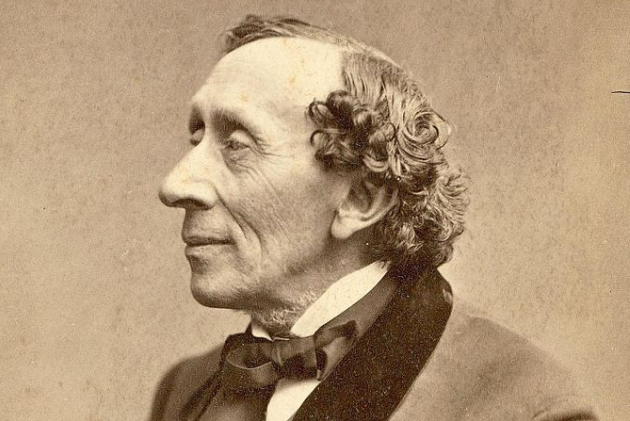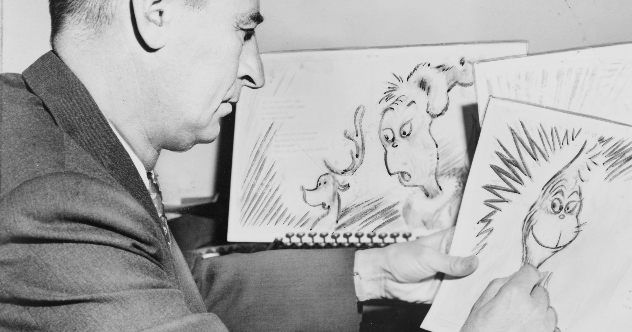 Humans
Humans  Humans
Humans  Animals
Animals 10 Animals That Humiliated and Harmed Historical Leaders
 History
History 10 Most Influential Protests in Modern History
 Creepy
Creepy 10 More Representations of Death from Myth, Legend, and Folktale
 Technology
Technology 10 Scientific Breakthroughs of 2025 That’ll Change Everything
 Our World
Our World 10 Ways Icelandic Culture Makes Other Countries Look Boring
 Misconceptions
Misconceptions 10 Common Misconceptions About the Victorian Era
 Mysteries
Mysteries 10 Strange Unexplained Mysteries of 2025
 Miscellaneous
Miscellaneous 10 of History’s Most Bell-Ringing Finishing Moves
 History
History 10 Great Escapes That Ended Right Back in Captivity
 Humans
Humans 10 Everyday Human Behaviors That Are Actually Survival Instincts
 Animals
Animals 10 Animals That Humiliated and Harmed Historical Leaders
 History
History 10 Most Influential Protests in Modern History
Who's Behind Listverse?

Jamie Frater
Head Editor
Jamie founded Listverse due to an insatiable desire to share fascinating, obscure, and bizarre facts. He has been a guest speaker on numerous national radio and television stations and is a five time published author.
More About Us Creepy
Creepy 10 More Representations of Death from Myth, Legend, and Folktale
 Technology
Technology 10 Scientific Breakthroughs of 2025 That’ll Change Everything
 Our World
Our World 10 Ways Icelandic Culture Makes Other Countries Look Boring
 Misconceptions
Misconceptions 10 Common Misconceptions About the Victorian Era
 Mysteries
Mysteries 10 Strange Unexplained Mysteries of 2025
 Miscellaneous
Miscellaneous 10 of History’s Most Bell-Ringing Finishing Moves
 History
History 10 Great Escapes That Ended Right Back in Captivity
Top 10 Wholesome Creators Who Were Anything But
In this chaotic world, one can always seek comfort in the warmth of whimsy. Innocent icons are fondly looked upon as one of the few things incorruptible. The problem is that these works are made by people. People are rarely incorruptible. The following 10 people show how artists in fields as charming as poetry or as playful as toys have hid behind their public reputation to be less than scrupulous.
Top 10 Gruesome Fairy Tale Origins
10 Hans Christian Andersen

Hans Christian Andersen wrote down two things, children stories and records of every time he masturbated. Thankfully, the two never overlapped. In his professional life, the man behind fairytales like “The Little Mermaid” and “The Snow Queen” remained pure. Outside of that, he challenged to contain his sexual urges. To control his desires, he masturbated with such regularity that he developed “penis sores.” Debauched accounts of every instance of onanism filled his diaries.
Outside of chronic masturbation, his life was remarkably chaste. Like his titular creation, Andersen considered himself an ugly duckling. Terribly afraid of sex, he could only fantasize about unreciprocated crushes on both men and women. He likely died a virgin. The closest he came to having sex was when he hired prostitutes. Even that transaction was still chaste. They were only employed to talk to him. When the conversation ended, he excused himself to, as Elsa would say, “let it go”.
9 Xavier Roberts

Xavier Roberts’ signature is more famous than the name it stands for. His cursive autograph rests on the foot of every Cabbage Patch Kid. In the 1980’s, parents rioted to get the latest must-have Christmas gift. Off the success of the unrivaled phenomenon, Roberts racked in a fortune. The women who conceived the idea made nothing.
Outside of tales of following an enchanted BunnyBee to a vegetable patch, Roberts was never candid about the dolls’ origin. He consistently opined that the toys were tokens in honor of the quilted dolls his mother used. This story was a concocted public relations stunt. The truth is simpler. He bought one of Martha Nelson Thomas’ Doll Babies at a craft show.
Many traits later found in Cabbage Patch Kids originated in Doll Babies, like the shriveled infant face or accompanying adoption papers and information sheets listing their interests. Thomas treated her dolls as people with individual personalities. They could not be besmirched with any insignia, even a copyright symbol. Roberts had no similar qualm.
Thomas eventually sued Roberts for intellectual property theft. Thomas cared little about the undisclosed amount of money earned in the settlement. She just wanted Roberts to admit that she was the toy’s true creator. Begrudgingly, he confessed the truth.
8 Lisa Frank

It was almost too sweet. Saccharine scenes of unicorns jumping over rainbows to share ice cream cones with dolphins were bound to hide something nefarious. Lisa Frank, the company, is beloved. Lisa Frank, the person, is hated.
In the height of the sticker fad, the need to maintain production fostered a toxic corporate climate. Former employees compared the working conditions to everything from an “abusive alcoholic home” to the “Rainbow Gulag” to, bluntly, “the world’s shi**iest employer.” Lisa Frank heavily restricted her employees’ rights. Visitors were forbidden from the office. Banned from speaking to their coworkers, the staff worked in complete silence. Frank secretly recorded employees’ calls to make sure they followed her demands.
Disobedient employees were verbally abused by Frank’s husband and CEO James Green. In cocaine rattled tirades, Green belittled the staff. When name calling was not enough, Green resorted to throwing chairs, padlocking employees in their office, or threatening their lives. With the smallest infraction to justify firing, Green withheld worker’s severance packages and unemployment benefits. A collective action eventually forced them to maintain this minimal right. Free from their contracts, the workforce left en masse. They deserved the break.
7 Robert Frost
Robert Frost’s poems are as modest as the winter trees he elegizes. Frost was not as pristine as fallen snow. Two roads diverged in the woods. He took the one less traveled, the road of being a vindictive jerk.
Fellow poets bore the brunt of Frost’s jealousy. Simultaneously assured that no rival could compare to his mastery and fearful of challengers, he heckled burgeoning poets during their readings. To distract one of Archibald MacLeish’s recitation, Frost lit a small fire in the back. When confronting the would-be arsonist, Bernard DeVoto told Frost, “You’re a good poet, Robert, but you’re a bad man.” Frost did not really disprove DeVoto’s accurate summary, once he spread rumors that DeVoto was mentally challenged. After similar provocation from Truman Capote, Frost forced the New Yorker to fire the cub reporter Capote.
Frost’s propensity for grudges was equally disastrous in his personal life. His own marriage was jeopardized after falsely accusing his wife of having an affair. One night he woke his children to warn them he was about to kill him and their mother. Luckily, he did not follow through on his threat.
6 Northern Calloway
On rare occasions, Sesame Street cannot chase the clouds away. In 1982, shopkeeper Mr. Hooper’s death darkened Jim Henson’s village. The episode is heralded for its deft handling of grief. The next shopkeeper gave the audience another reason to mourn.
In the show, Mr. Hooper’s store responsibilities were handed over to Northern Calloway’s David. As a beloved mainstay of the show, Calloway earned a lot of good will over his eighteen year tenure. In exchange, Sesame Street tolerated his escalating chaotic behavior.
In the early 1980’s, Calloway rampaged through the streets of Nashville. The pantsless entertainer bashed in car windows with an iron rod. In 1989, Calloway’s mental deterioration was evident. Executives fired him after biting music director Danny Epstein’s ear. The final straw was harassing teenage actress Alison Bartlett. As a result, he was sent to Stony Lodge Psychiatric Hospital. While resisting his caretakers’ restraints, Calloway had a seizure. The subsequent cardiac arrest killed the 41-year-old actor.
5 Thomas Kinkade
Thomas Kinkade, “The Painter of Light” desired to shine “God’s light” in a secular artworld. Critics dismissed his kitschy pastoral landscapes as filled with more trees than artistic merit. The American public disagreed. Millions of knick-knacks sported Kinkade’s designs. The popularity financed a destructive drinking career. That light casts a dark shadow.
Kinkade was a fraud that inflated his sales figures to trick gallery owners to invest with him. Operators displayed Kinkade’s work falsely believing their value was secure. It was not. In early 2002, his stock value fell from $25 to $3 dollars. While the investors went bankrupt, Kinkade’s personal wealth was unaffected.
The millions in royalties fueled drunken escapades. Disastrous incidents include storming the stage of a Siegfried & Roy performance or urinating on a Winnie the Pooh statute at Disneyland. Worst of all, multiple female fans accused him of groping them without their consent. When he drank himself into a temporary coma, his family held an intervention about his alcoholism. Doctors feared that if he did not control his drinking, he would die. After mixing valium with liquor, that is exactly what happened. He was 54.
4 Bing Crosby
Few names more evoke the wistful yearning of the Christmas carol than Bing Crosby. Immortal standards like “White Christmas,” “I’ll Be Home for Christmas,” or the ill-conceived duet with David Bowie, “The Little Drummer Boy” are forever associated with the crooner. His kids likely wished he did not make it home for the holidays.
Worried his wealth would spoil his sons, Bing imposed a strict regimen of acceptable behavior. The corporal punishment was borderline torturous. Each week, Bing placed his sons on a scale. If their weight was above their father’s arbitrary standard, Bing beat them with sticks until they bled. To stay in line with the dietary rules, son Philip occasionally forwent breakfast. One time, Phillip hid his eggs and bacon under a rug. Bing fished the meal off the floor and forced Phillip to eat it, “dirt, hairs, and all.” The boys were sometimes compelled to wear their dirty underwear around their faces until they went to bed in a practice so common it was nicknamed, “the Crosby lavalier.”
The humiliation wore down the family. Their days were not merry and bright. Unable to prevent the scolding, wife Dixie turned to alcoholism. All four sons eventually did as well. One son regularly checked himself into mental institutions for treatments. Another two faced their depression by killing themselves.
3 Marvin Glass
Marvin Glass created three main products: Mouse Trap, a toy where convoluted contraptions ensnare unwilling participants, Operation, a game focused on human anatomy, and Rock ‘em Sock ‘em Robots, a toy built around confrontation. One could say a lot about Glass, but they cannot deny the man put his life into his work.
Obsessive over his board game empire, Glass decked his house with the latest tools in home security. Windows were bolted and triple locked. Cameras recorded anyone who approached his home on close circuit television. Armed guards were stationed around the clock. Paranoia turned him into a reclusive shut-in.
The delusion did not impede his social life. Modeled after friend Hugh Hefner’s notorious Playboy Mansion, his manor constantly hosted orgies. Not all of the encounters were consensual. Glass had a pattern of “manipulative and predatory” behavior. He often cajoled woman to have sex with him by claiming it was the only way to prevent him from committing suicide. It probably did, temporarily, help relieve his depression. Glass brought joy to millions. To many, including himself, he did not.
2 Dr. Seuss

You’re a mean one Mr. Geisel. Theodore Geisel, better known under his pseudonym Dr. Seuss, entertained generations of children with whimsical tales. The nonsensical rhymes were a collaborative effort between him and his wife, Helen Palmer Geisel. Curiously, Theodore co-wrote these charming stories without particularly caring for his market demographic. Helen was consumed with wanting kids.
A lifelong victim of Guillain-Barre syndrome, an autoimmune disorder that causes paralysis and tingling, Helen thought she could finally find comfort as a mother. At 33, Helen was hospitalized with abdominal pains. The doctors treated her by removing her ovaries. The operation ensured she could never conceive her own children.
Infertility threw Helen into a depression. The emotional turmoil exacerbated her already debilitating condition. She then learned an even worst heartbreak. Unable to keep his wocket in his pocket, Theodore cheated on Helen after 41 years of marriage with the married Audrey Diamond. In 1967, Helen purposely overdosed on nearly 300 pills. Her suicide note blamed Theodore for the despair he put her through. He did not change his poor behavior towards women. A year after Helen’s death, Seuss married Audrey Diamond on the condition that she cut off contact to her then-husband and children.
1 Peter Robbins
The judge warned him to not be a “blockhead.” Peter Robbins appreciated the nod to his earlier fame. He did not heed the advice. In the 1960’s, Robbins voiced the iconic Charlie Brown in the “Peanuts’” most celebrated productions. He played the titular role in holiday staples, A Charlie Brown Christmas and It’s the Great Pumpkin, Charlie Brown. When puberty hit, the acting roles vanished. He had little options left.
In 2013, Robbins’ girlfriend, Shawna Kern, dumped him. He felt betrayed after just paying for her to get breast implant surgery. In a fury, he abused both her and their dog, a move Snoopy would surely condemn. She fled for her safety.
Banned from contacting Kern, Robbins started stalking her. Kern’s phone rang for hours with Robbins threats on the other line. He grew obsessed with Lori Saltz, the plastic surgeon who performed the procedure that Robbins saw as the reason behind the breakup. When the police investigated the couple for domestic abuse, Robbins hired a hitman to try to murder the local sheriff. He was sentenced to one year in jail before the plan was acted upon. By 2015, he was back in courtroom for violating his probation. Due to increasing signs of bipolar disorder and paranoid schizophrenia, he was transferred to a psychiatric hospital instead. His luck with animated footballs was the first indication that he could never learn from his mistakes.
10 Family-Unfriendly Facts From The Life Of Dr. Seuss
About The Author: Nate Yungman was just having wholesome fun with this article. If you thought he rocked it, you can follow him on twitter @nateyungman. If you want to sock him, you can email any questions of comments to [email protected]








